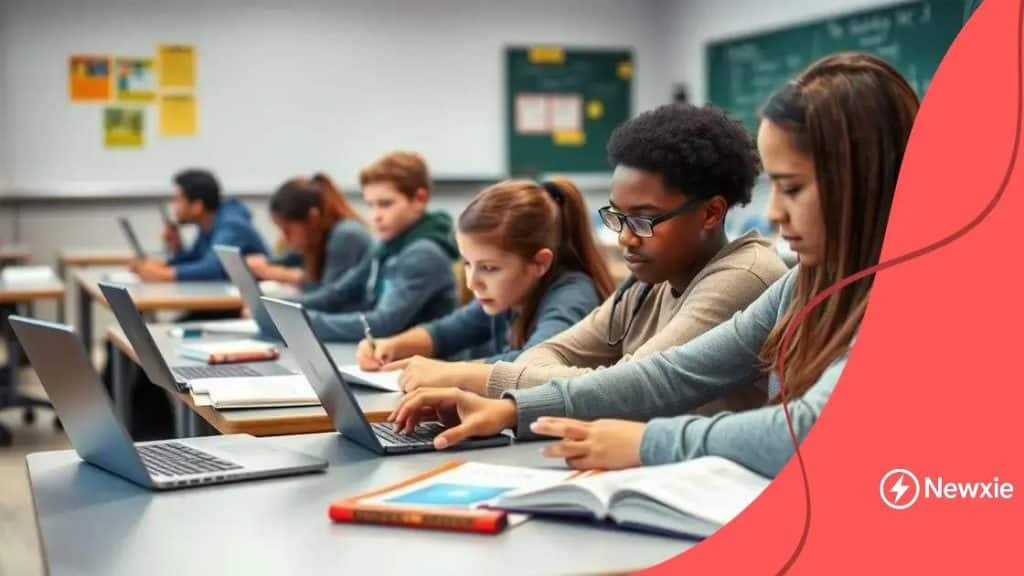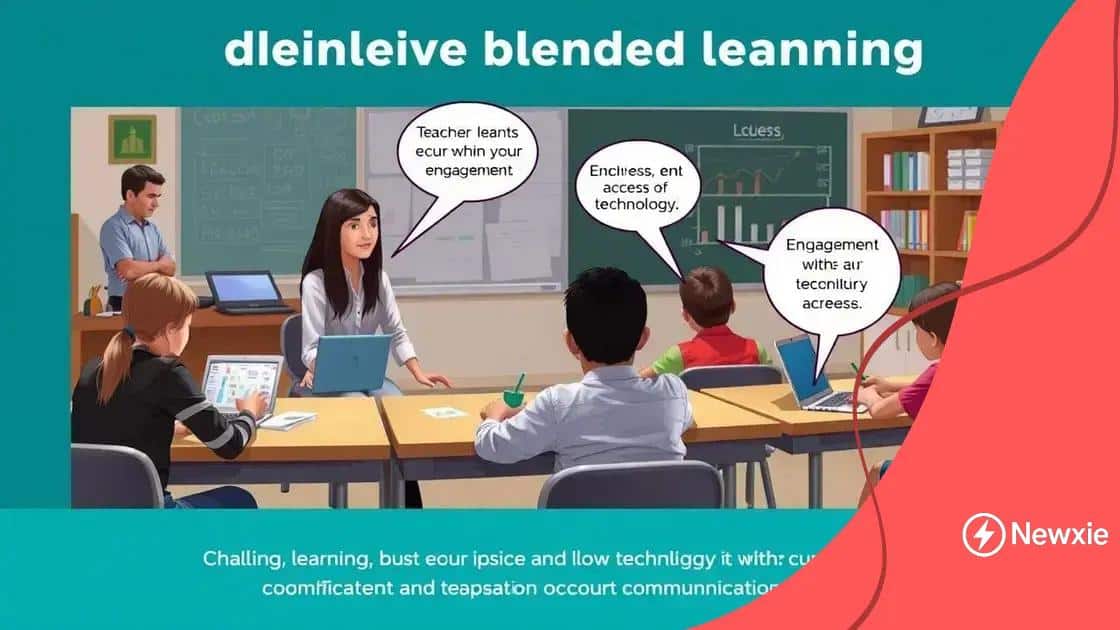How effective blended learning models are proving to be

Anúncios
Blended learning models effectively combine traditional and online education to enhance student engagement, provide personalized learning experiences, and prepare learners for future challenges in a flexible learning environment.
How effective blended learning models are proving to be is a topic worth exploring, especially as education evolves. Have you ever wondered how this approach could change your learning experience? Let’s dive in!
Understanding blended learning models
Anúncios
Blended learning models are changing the way we approach education. They combine traditional classroom methods with online learning, creating a dynamic learning environment. Understanding how these models work is essential for educators and students alike.
What is blended learning?
Blended learning is a mix of face-to-face and online instruction. For instance, students might attend a physical classroom for some lessons while completing others through digital platforms. This flexibility allows for personalized learning experiences tailored to individual needs.
Key components of blended learning models
- Online content delivery: Lessons are provided through videos, interactive activities, and readings.
- Face-to-face interactions: Teachers assess students personally and provide feedback in real time.
- Data-driven insights: Educators can track progress and adapt lessons based on student performance.
One of the main advantages of blended learning is that it caters to various learning styles. Some students excel with visual aids while others benefit from hands-on activities. By leveraging both methods, educators can address these needs effectively. The integration of technology in this model encourages students to take ownership of their learning.
Additionally, blended learning can enhance engagement. For example, online forums allow students to discuss topics outside the classroom, promoting collaboration. Also, access to digital resources means students can explore subjects at their own pace. This aspect often leads to deeper understanding and retention of information.
Anúncios
Overall, as education continues to evolve, understanding blended learning models becomes more critical. They not only provide flexibility but also foster an engaging learning atmosphere, essential for success in today’s world.
The benefits of blended learning
Blended learning offers numerous advantages for both students and educators. This approach merges traditional face-to-face instruction with online learning, creating a more enriching educational experience.
Enhanced flexibility
One of the most significant benefits of blended learning is the flexibility it provides. Students can access course materials and complete assignments at their own pace. This means they can learn in a way that suits their individual schedules, making education more accessible.
Personalized learning experiences
With blended learning, educators can tailor lessons to meet the needs of each student. This personalized approach helps students grasp concepts more effectively, as they are not limited to a one-size-fits-all teaching method.
- Increased engagement: Engaging online tools and interactive content keep students interested.
- Immediate feedback: Digital platforms allow for quick assessment and feedback, helping learners make timely adjustments.
- Collaboration: Online forums encourage students to collaborate and share ideas, enhancing their understanding.
Furthermore, blended learning helps to prepare students for the future. As technology becomes increasingly integrated into various industries, students familiar with online platforms will be more equipped to navigate digital environments. This real-world application of skills leads to better job readiness.
Additionally, teaching in a blended environment can offer educators new insights. They can analyze student data to identify which methods work best and refine their teaching strategies accordingly. This adaptability ensures that they remain effective in their instruction.
Challenges in implementing blended learning

Implementing blended learning can bring great rewards, but it also comes with several challenges. Understanding these obstacles is crucial for educators looking to adopt this approach effectively.
Technology access and training
One major challenge is ensuring that all students have access to the necessary technology. Not every student has a computer or high-speed internet at home, which can create disparities in learning opportunities. Moreover, educators often need training to effectively use digital tools and manage blended environments.
Creating engaging content
Developing engaging online content is essential for maintaining student interest. It’s not enough to simply post lectures online; educators must create interactive and compelling materials that engage students. This requires time and effort, which can be challenging for busy teachers.
- Curriculum alignment: Teachers must ensure that online and face-to-face components align with the curriculum.
- Student motivation: Keeping students motivated in a blended format can be tough, especially for those who thrive in traditional settings.
- Assessment challenges: Determining how to assess students effectively in both environments can lead to confusion.
Furthermore, blended learning requires a shift in mindset for both educators and students. Teachers used to traditional methods may find it difficult to adapt to new technologies and approaches. Similarly, some students may struggle with taking more responsibility for their own learning.
Another obstacle is ensuring that communication remains effective between students and teachers. In a blended environment, the lines may blur between online and offline interactions, leading to misunderstandings. Developing clear communication strategies is key to overcoming this challenge.
Best practices for educators
For educators implementing blended learning, following best practices can significantly enhance the effectiveness of this approach. Establishing these practices provides a strong foundation for both teaching and learning.
Designing engaging online content
Creating engaging online content is essential for student motivation. Use multimedia elements like videos, quizzes, and interactive simulations to make lessons more dynamic. This variety helps cater to different learning styles, which can lead to better understanding.
Building a supportive community
Fostering a sense of community among students is vital in a blended learning environment. Encourage online discussions and collaborative projects that allow students to connect with one another. This social interaction can enhance their learning and help them feel more involved.
- Clear communication: Keep communication channels open and ensure students know how to reach out for help.
- Regular feedback: Provide timely feedback on assignments to guide student progress and keep them engaged.
- Flexibility: Be adaptable in your teaching methods to meet the needs of individual students.
Additionally, incorporating regular check-ins can help educators gauge student comprehension and emotional well-being. These check-ins provide opportunities for personal interaction, allowing teachers to identify students who may need additional support.
Utilizing data effectively is another best practice. Analyzing performance metrics from both in-person and online assessments can shed light on areas needing improvement. By tracking progress consistently, educators can adjust their teaching strategies accordingly.
The future of blended learning in education
The future of blended learning in education looks bright as technology continues to evolve. This approach is gaining traction, offering new possibilities for enhancing student learning experiences.
Increased adoption of technology
As more schools invest in technology, blended learning will likely become the norm. With resources such as interactive learning platforms and virtual classrooms, educators can create dynamic lessons that engage students effectively. Students will benefit from personalized learning paths, allowing them to progress at their own pace.
Focus on collaboration
Future blended learning models will emphasize collaboration among students and teachers. With tools like online discussion forums and collaborative projects, learners will have more opportunities to connect and share ideas. This sense of community is essential for building critical social skills.
- Global classrooms: Students will have access to global perspectives, learning from peers around the world.
- Data analytics: Educators will use data to track student progress and adapt teaching methods accordingly.
- Continuous feedback: Real-time assessments will provide immediate insights into student performance.
Moreover, the future of education will likely embrace a hybrid model, blending in-person and online instruction seamlessly. This flexibility can accommodate diverse learning styles, ensuring that all students have access to high-quality education.
As educators become more skilled in using technology, they will be better equipped to create engaging and effective learning environments. By focusing on student-centered approaches, the effectiveness of blended learning can be greatly enhanced, ensuring students are well-prepared for the demands of the modern workforce.
FAQ – Frequently Asked Questions about Blended Learning in Education
What is blended learning?
Blended learning combines traditional face-to-face teaching with online learning, allowing for a flexible and personalized educational experience.
What are the benefits of blended learning?
Blended learning increases flexibility, enhances student engagement, and allows for personalized learning experiences tailored to individual needs.
What challenges do educators face when implementing blended learning?
Challenges include ensuring access to technology, creating engaging online content, and maintaining effective communication between students and teachers.
How can educators ensure success in a blended learning environment?
By designing engaging content, fostering a supportive community, providing regular feedback, and utilizing data to track student progress, educators can enhance the effectiveness of blended learning.
SEE MORE CONTENT




